Table of Contents
Understanding the Basics of an Ornamental Tree
When it comes to landscaping, few elements are as versatile as an ornamental tree. A decorative tree isn’t just for large estates or gardens. It can make a huge impact in any space, from a spacious backyard to a small urban lot. But before you start planting, it’s important to understand what makes an ornamental tree so special and how it can elevate your outdoor space. So, what exactly is an ornamental tree, and why should you consider adding one to your garden?
What Is an Ornamental Tree?
A decorative tree is chosen for its beauty rather than for its fruit or timber. This type of tree can be stunning, featuring vibrant flowers, unique bark, and distinctive leaves. While an ornamental tree provides benefits like shade and improved air quality, its main purpose is to enhance the aesthetic appeal of your landscape.
The Many Varieties of a decorative tree
One of the most exciting aspects of a decorative tree is the sheer variety available. From spring’s breathtakingly colorful, flowering trees to evergreens that provide structure year-round, the options are endless. Here are a few examples of popular decorative tree types:
- Flowering Tree: This tree offers bursts of color in the spring, such as magnolias or cherry blossoms. Its seasonal blooms can be a focal point in your garden, drawing the eye and setting a vibrant mood.
- Deciduous Tree: This type of tree loses its leaves in the fall but offers spectacular autumn colors, like the fiery reds and golds of maples.
- Evergreen Tree: While lacking dramatic flowers, this tree adds year-round greenery. Its consistent foliage gives a refined, elegant look.
Why Choose a decorative tree for Your Landscape?
Why consider an ornamental tree over traditional landscaping options like shrubs or perennials? Here are some compelling reasons:
- Year-Round Beauty: Many decorative tree varieties offer beauty across multiple seasons. Imagine watching your tree bloom in spring, fill with lush green leaves in summer, display vibrant autumn foliage, and stand tall with striking bark in winter.
- Space-Saving Design: If you’re limited on space but still want to make an impact, a decorative tree can be ideal. With various sizes available, there’s a decorative tree for nearly every type of space, from small courtyards to expansive gardens.
- Low Maintenance: Although any plant needs care, a decorative tree is often low-maintenance once established. Many varieties are pest-resistant, drought-tolerant, and resilient, making them suitable for both beginner gardeners and seasoned pros.
Spotlight on Popular Ornamental Tree Types
Some decorative tree types stand out for their beauty and unique features. Below is an overview of the most popular varieties, their key characteristics, and the ideal climates and locations for their growth:
Hibiscus Tree
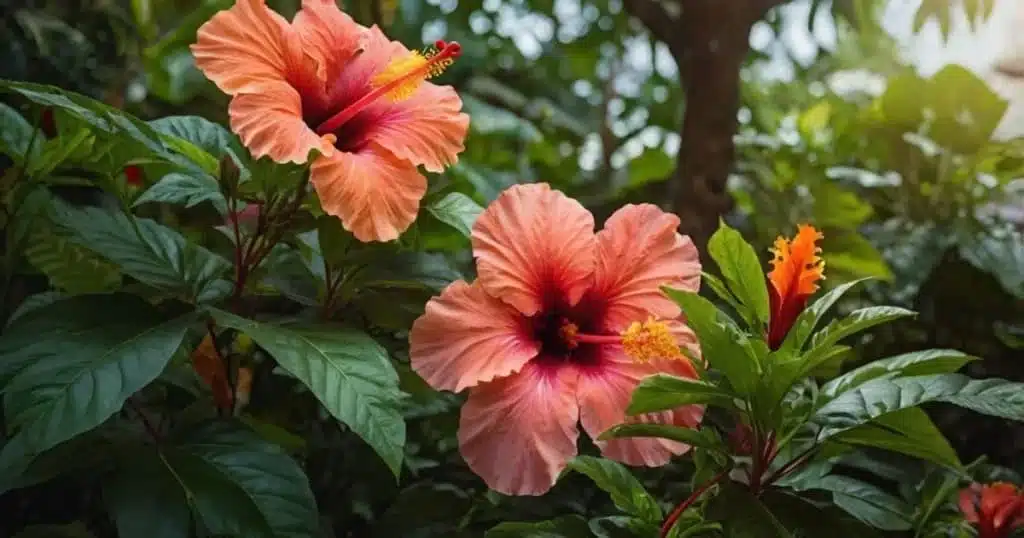
- Description: Known for its vibrant tropical blooms, the hibiscus tree adds an exotic touch to any garden. Colors range from red to pink, white, and orange.
- Highlights: Long-lasting blooms throughout summer. Ideal for warm climates.
- Favorable Climate: Warm temperate to tropical zones (USDA zones 9–11).
- Favorable Location: Full sun with well-drained, slightly acidic soil. Protect from strong winds.
Learn all about how to grow and care for a hibiscus tree to add a tropical touch to your garden.
Japanese Magnolia
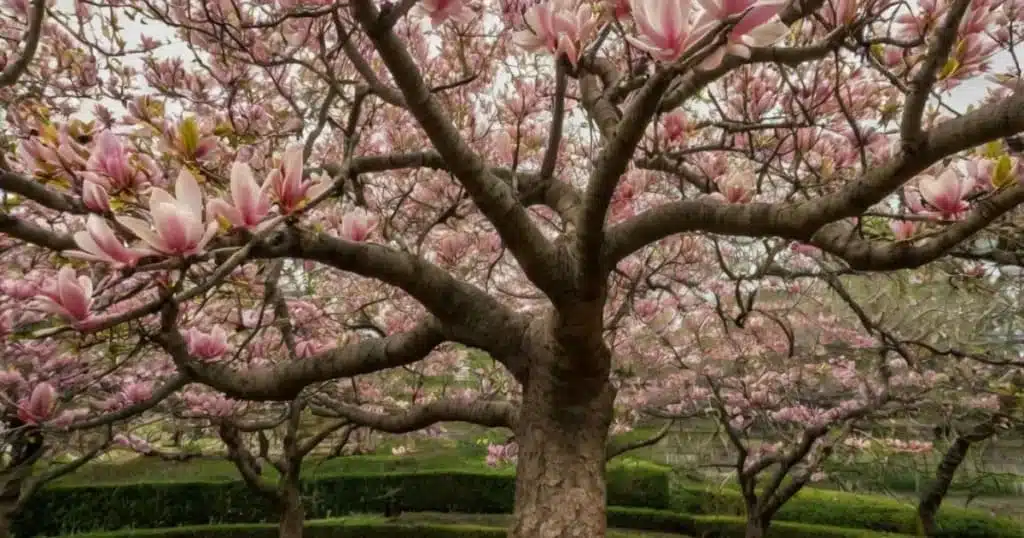
- Description: Famous for its tulip-shaped flowers, the Japanese Magnolia brings a burst of color in early spring.
- Highlights: Its pink or purple flowers are a stunning focal point before leaves emerge.
- Favorable Climate: Mild to temperate climates (USDA zones 5–9).
- Favorable Location: Full sun or partial shade. Thrives in rich, moist, well-drained soil. Protect young trees from late frosts.
For gardeners interested in adding elegance and charm to their outdoor space, discover how to grow and care for a Japanese Magnolia tree and enjoy its stunning blooms throughout the season.
Jane Magnolia
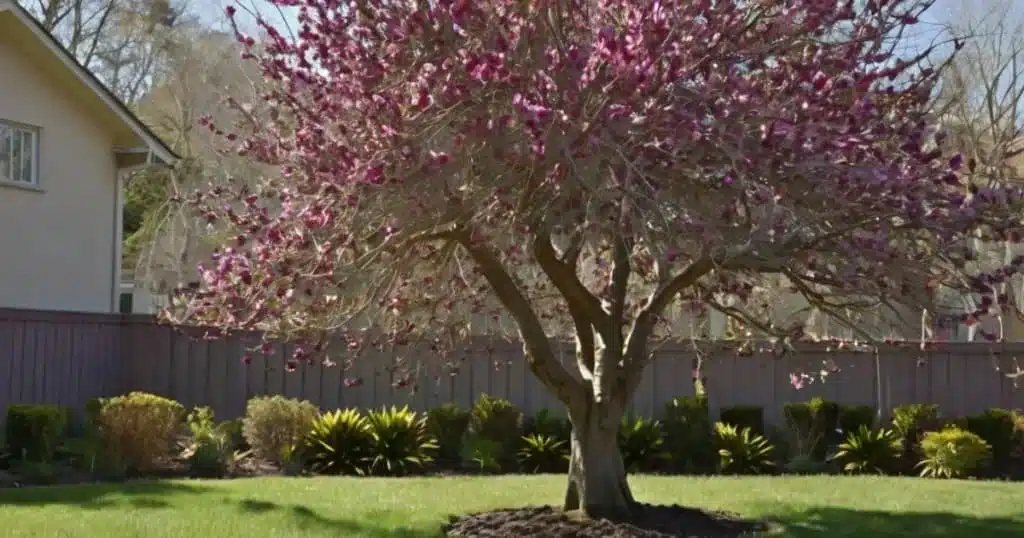
- Description: A compact variety of magnolia, the Jane Magnolia is perfect for small gardens. Its flowers are deep purple on the outside and white on the inside, offering a refined aesthetic.
- Highlights: Cold-hardy and blooms later than other magnolias, reducing frost damage risk.
- Favorable Climate: Temperate zones (USDA zones 4–8).
- Favorable Location: Full sun or partial shade in nutrient-rich, slightly acidic soil. Shield from cold winds for optimal flowering.
Ivory Silk Japanese Lilac
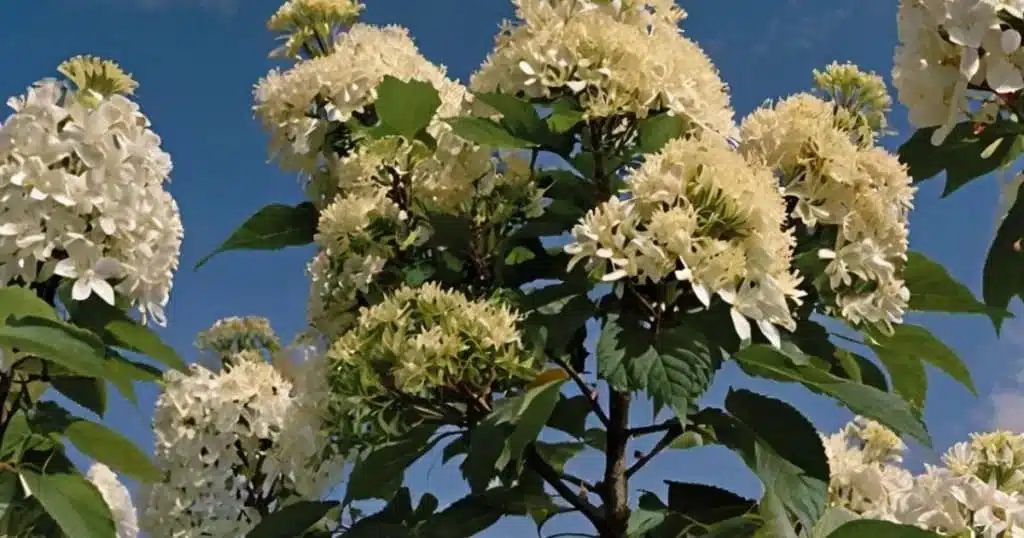
- Description: This Japanese lilac tree stands out with its creamy white flower clusters, blooming in late spring or early summer.
- Highlights: Besides its aesthetic appeal, it emits a soft, pleasant fragrance.
- Favorable Climate: Cool to temperate climates (USDA zones 3–7).
- Favorable Location: Full sun or partial shade. Adapts well to urban soils, including slightly alkaline ones, and tolerates pollution.
Wisteria Tree
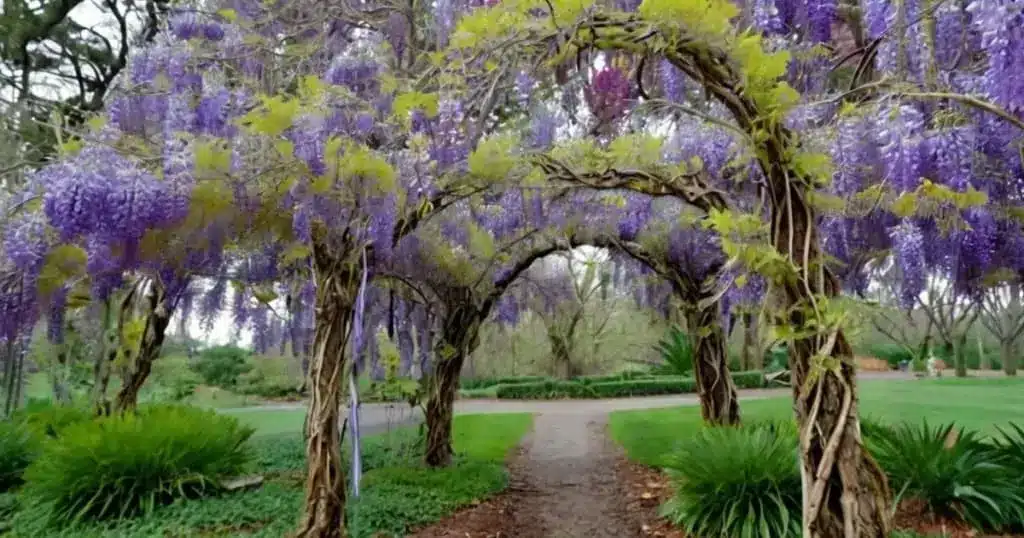
- Description: With its cascading clusters of flowers in shades of purple, blue, or white, the wisteria tree adds a romantic vibe to any outdoor space.
- Highlights: Stunning when in full bloom, it can be grown as a tree or vine.
- Favorable Climate: Temperate zones (USDA zones 5–9).
- Favorable Location: Full sun for optimal flowering in rich, moist, and well-drained soil. Requires sturdy support if grown as a climber.
Ornamental trees are versatile additions to any garden, from large backyards to small urban spaces. Choosing the right tree depends on your local climate. Use the USDA Plant Hardiness Zone Map to find trees suited to your area and ensure success in your landscaping project.
How to Design Your Garden with an Ornamental Tree
A decorative tree can transform a garden, but its placement and combination with other elements are crucial to creating a cohesive and beautiful outdoor space. Here are key design tips to inspire your landscaping:
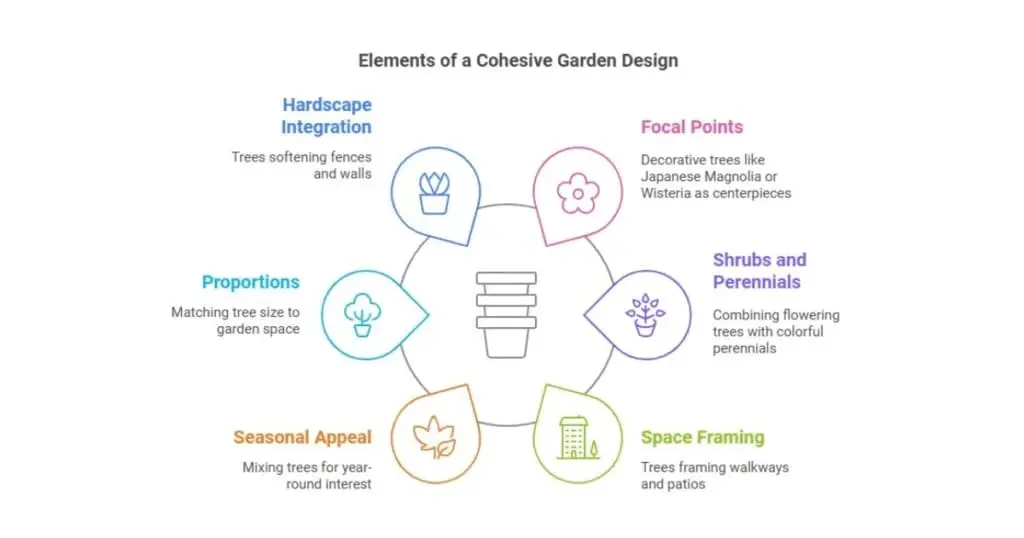
- Create Focal Points: Use a decorative tree with striking features, like a Japanese Magnolia or Wisteria tree, as a centerpiece. Place it where it can draw attention, such as near entryways or patios.
- Combine with Shrubs and Perennials: Pair a flowering ornamental tree with complementary shrubs or ground cover for layered textures. For example, combine the blooms of an Ivory Silk Japanese Lilac with colorful perennials like lavender.
- Frame and Define Spaces: Use a decorative tree to frame walkways, garden benches, or patios. Compact options like the Jane Magnolia are ideal for smaller areas or natural dividers.
- Play with Seasonal Appeal: Mix trees with different seasonal highlights to ensure year-round interest. Pair a hibiscus tree for summer blooms with a Japanese Maple for fall colors.
- Balance Proportions: Match the size and growth habit of the tree to your space. Dwarf varieties suit urban courtyards, while taller species anchor expansive gardens.
- Integrate with Hardscapes: An ornamental tree can soften the look of fences, walls, or pergolas. A wisteria tree, for instance, adds a cascading, romantic effect.
Conclusion
An ornamental tree is an incredible way to transform your outdoor space, offering beauty, functionality, and timeless appeal. Whether you’re looking to create a vibrant spring display, add shade with a touch of elegance, or craft a serene retreat, the variety of ornamental tree options ensures there’s one for every garden. With proper care and thoughtful selection, a decorative tree can thrive for decades, enhancing not just the look but also the feel of your space.
Ready to bring your garden to life with a decorative tree ? Start exploring your options today, and don’t hesitate to seek expert advice to find the perfect tree for your climate, space, and style. Share your journey or ask your questions in the comments below—let’s grow together!
Frequently Asked Questions (FAQ)
1. What are ornamental trees, and how do they differ from other types of trees?
Ornamental trees are chosen for their beauty, not for fruit or wood. These trees are prized for their flowers, foliage, and bark. Their beauty makes them perfect for gardens and landscapes. Unlike fruit trees, which focus on yielding produce, decorative trees add charm, texture, and seasonal interest to your yard.
2. How do I choose the right ornamental tree for my garden?
Choose the right decorative tree. Consider your garden’s size, your climate, and the tree’s seasonal look. Think about whether you want a tree that offers spring blooms, autumn foliage, or evergreen appeal. Additionally, make sure to select a tree that matches the maintenance level you’re comfortable with and fits the space you have available.
3. How do I care for my ornamental tree?
Caring for decorative trees includes regular watering, pruning, and fertilizing. It’s important to water deeply, especially in the tree’s first year. Prune to remove dead or damaged branches and encourage healthy growth. Fertilize once or twice a year with a balanced, slow-release fertilizer. Mulching around the base helps retain moisture and suppresses weeds.
4. Do ornamental trees need a lot of maintenance?
decorative trees are generally low-maintenance, but they do require some care to ensure they thrive. Water regularly. Prune and manage pests occasionally. This will keep them healthy and looking good. Some trees require more attention than others, so be sure to select a tree that fits your time and maintenance preferences.
5. What are the best ornamental trees for small gardens?
For smaller spaces, it’s best to choose compact or dwarf varieties of decorative trees. Japanese Maples, Dogwoods, and Cherry Blossoms are great for small gardens. These trees add beauty without overwhelming the space. So, they are ideal for urban areas or small yards.
6. When is the best time to plant an ornamental tree?
The best time to plant decorative trees is in early spring or late fall when the weather is cooler. This gives the tree enough time to establish its roots before the summer heat or winter cold sets in. Make sure the soil is well-drained and that you’re planting at the correct depth for your tree species.
7. Can ornamental trees thrive in all climates?
Many decorative trees can adapt to various climates. But, it’s important to choose species suited to your specific environment. Cold-hardy trees suit cooler climates. Heat-tolerant, drought-resistant trees thrive in warmer areas. Always check the tree’s hardiness zone to ensure it will thrive in your location.
8. How can I protect my ornamental tree from pests and diseases?
Regularly inspect your tree for signs of pests such as discolored leaves, webs, or holes. If you notice an issue, consider using natural pest control options like neem oil or insecticidal soap. Ensure your tree is well-watered and healthy, as strong trees are more resistant to disease. If the infestation is severe, consulting a professional arborist is always a good idea.

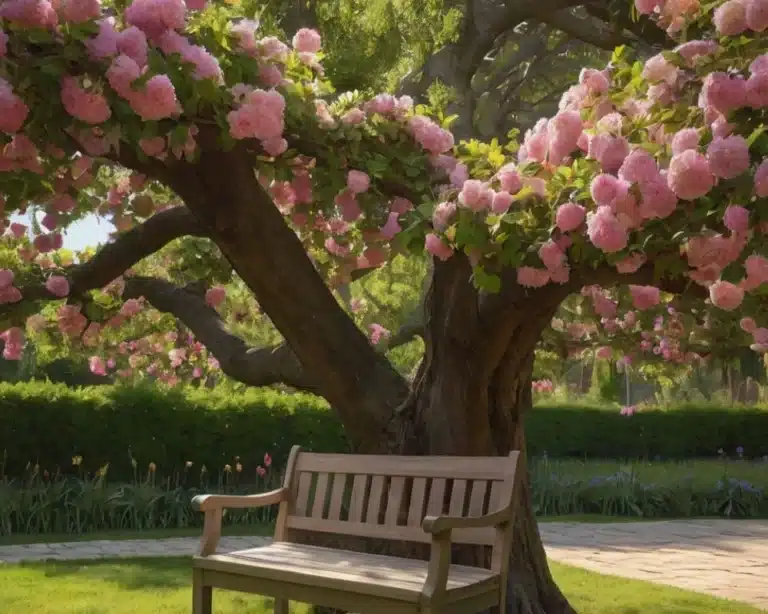
6 thoughts on “Ornamental Trees: 5 Elegant Picks for Your Garden”